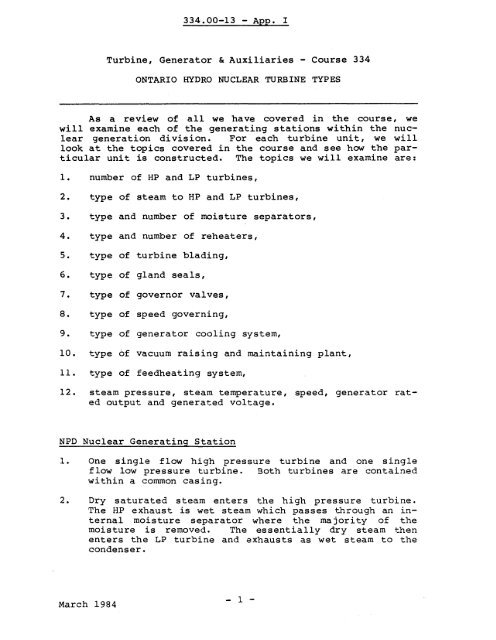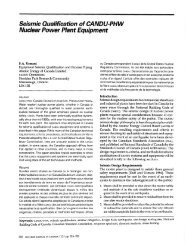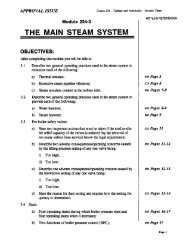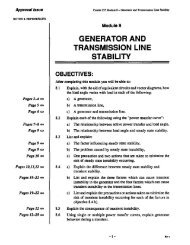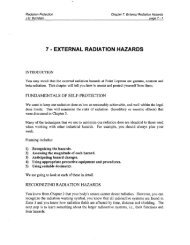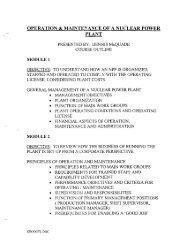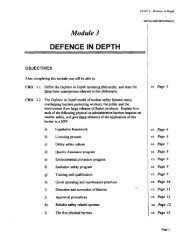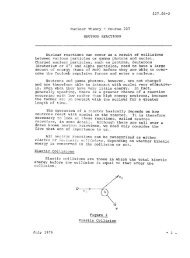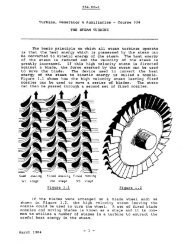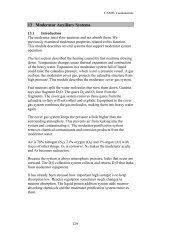334.00-13 - App. I Turbine, Generator & Auxiliaries ... - Canteach
334.00-13 - App. I Turbine, Generator & Auxiliaries ... - Canteach
334.00-13 - App. I Turbine, Generator & Auxiliaries ... - Canteach
Create successful ePaper yourself
Turn your PDF publications into a flip-book with our unique Google optimized e-Paper software.
<strong>334.00</strong>-<strong>13</strong> - <strong>App</strong>. I<br />
<strong>Turbine</strong>, <strong>Generator</strong> & <strong>Auxiliaries</strong> - Course 334<br />
ONTARIO HYDRO NUCLEAR TURBINE TYPES<br />
As a review of all we have covered in the course, we<br />
will examine each of the generating stations within the nuclear<br />
generation division. For each turbine unit, we will<br />
look at the topics covered in the course and see how the particular<br />
unit is constructed. The topics we will examine are:<br />
1. number of HP and LP turbines,<br />
2. type of stearn to HP and LP turbines,<br />
3. type and number of moisture separators,<br />
4. type and number of reheaters,<br />
5. type of turbine blading,<br />
6. type of gland seals,<br />
7. type of governor valves,<br />
8. type of speed governing,<br />
9. type of generator cooling system,<br />
10. type of vacuum raising and maintaining plant,<br />
II. type of feedheating system,<br />
12. stearn pressure, stearn temperature, speed, generator rated<br />
output and generated voltage.<br />
NPD Nuclear Generating Station<br />
1. One single flow high pressure turbine and one single<br />
flow low pressure turbine. Both turbines are contained<br />
within a common casing.<br />
2. Dry saturated stearn enters the high pressure turbine.<br />
The HP exhaust is wet steam which passes through an internal<br />
moisture separator where the rna jority of the<br />
moisture is removed. The essentially dry steam then<br />
enters the LP turbine and eXhausts as wet steam to the<br />
condenser.<br />
March 1984<br />
- 1 -
<strong>334.00</strong>-<strong>13</strong> -<strong>App</strong>. I<br />
3. One centrifugal type water separator is located within<br />
the common casing between the HP and LP turbine.<br />
Governor<br />
steam<br />
valves<br />
HP <strong>Turbine</strong><br />
Internal Moisture<br />
Separator<br />
NPD NGS <strong>Turbine</strong><br />
Figure <strong>13</strong>.1<br />
4. Steam reheaters are not used.<br />
LP <strong>Turbine</strong><br />
5. The high pressure turbine has impulse blading.<br />
pressure turbine has reaction blading.<br />
The low<br />
6. The high pressure turbine has a steam sealed labyrinth<br />
gland. The low pressure turbine has a centrifugal water<br />
gland.<br />
7. The turbine has four nozzle type governor steam valves.<br />
8. The speed governor is centrifugal fly-ball.<br />
9. The generator is air cooled.<br />
10. A steam air ejector is used for initial vacuum raising.<br />
The vacuum is maintained by motor driven vacuum pumps.<br />
- 2 -
<strong>334.00</strong>-<strong>13</strong> - <strong>App</strong>. I<br />
1. One single flow high pressure turbine, one single flow<br />
low pressure turbine and one double flow low pressure<br />
turbine.<br />
2. Dry saturated steam enters the high pressure turbine.<br />
The HP exhaust is wet stearn which passes to moisture<br />
separators where the majority of the moisture is removed.<br />
The essentially dry steam then enters a live stearn<br />
reheater where it is heated approximately 70°C above the<br />
saturation temperature. This superheated steam then<br />
enters the LP turbine and eXhausts as wet steam to the<br />
condenser.<br />
3. Two centrifugal type water separators. (One separator<br />
located in each of the two exhaust lines from the HP<br />
turbine.)<br />
4. Two tube in shell live steam reheaters (one reheater in<br />
each of the two HP turbine exhaust lines downstream of<br />
the moisture separators).<br />
5. The high pressure turbine has impulse blading.<br />
pressure turbines have reaction blading.<br />
The low<br />
6. The HP turbine gland is a combination of steam labyrinth<br />
gland and water gland. The LP turbine glands are water<br />
glands.<br />
7. The turbine has two throttle type governor steam valves.<br />
8. The speed governor is centrifugal flyball.<br />
9. The generator rotor is hydrogen cooled; the generator<br />
stator is water cooled.<br />
10. A steam hogging ejector is used for initial vacuum raising.<br />
The vacuum is maintained by steam maintaining<br />
ejectors.<br />
11. A regenerative feedheating system is used with the following<br />
feedheaters:<br />
stator water coolers<br />
air ejector condenser<br />
gland exhaust condenser<br />
drain cooler<br />
three LP feedheaters<br />
deaerator<br />
two HP feedheaters<br />
preheater internal to the steam generator<br />
- 4 -
12. HP turbine<br />
HP turbine<br />
LP turbine<br />
LP turbine<br />
Speed:<br />
Output:<br />
Voltage:<br />
<strong>334.00</strong>-<strong>13</strong> - <strong>App</strong>. I<br />
inlet.: 3880 kPa(a} and 248°c<br />
exhaust: 410 kPa(a}, 144°C and 12% moisture<br />
inlet: 400 kPa(a} and 221°C<br />
exhaust: 3.5 kPa(a}, 25°c and 12% moisture<br />
1800 rpm<br />
220 MW(e}<br />
18,000 volts<br />
Pickering Nuclear Generating Station A<br />
ESV GSV<br />
ESV GSV<br />
MiS<br />
HP<br />
RV<br />
RV<br />
To Condensers<br />
t<br />
RV<br />
RV<br />
MiS 1 1<br />
To Condensers<br />
ESV = Emergency Stop Valve<br />
GSV = Governor Steam Valve<br />
Mis = Moisture Separator<br />
Pickering NGS-A <strong>Turbine</strong><br />
Figure <strong>13</strong>.3<br />
- 5 -<br />
RV<br />
RV<br />
IV = Intercept Valve<br />
RV = Release Valve<br />
R/H = Reheater
<strong>334.00</strong>-<strong>13</strong> - <strong>App</strong>. I<br />
1. One double flow high pressure turbine and three double<br />
flow low pressure turbines.<br />
2. Dry saturated steam enters the high pressure turbine.<br />
The HP exhaust is wet steam which passes to moisture<br />
separators where the majority of the moisture is removed.<br />
The essentially dry steam then enters a live steam<br />
reheater where it is heated approximately 75°c above the<br />
saturation temperature. This superheated steam then<br />
enters the LP turbine and eXhausts as wet steam to one<br />
of the condensers located under each LP turbine.<br />
3. Four centrifugal type water separators (one separator<br />
located in each of the four exhaust lines from the HP<br />
turbine) •<br />
4. Two tube in shell live steam reheaters (one reheater on<br />
each side of the turbine receives the combined exhaust<br />
from two moisture separators).<br />
5. The high pressure turbine has reaction blading. The low<br />
pressure turbines have reaction blading.<br />
6. The HP and LP turbine glands are steam,sealed labyrinth<br />
glands.<br />
7. Four throttle valves are used for governor steam valves.<br />
8. The speed governor is centrifugal flyball.<br />
9. The generator rotor is hydrogen cooled: the generator<br />
stator is water cooled.<br />
10. Three motor driven screw type vacuum pumps are used for<br />
vacuum raising: one of these pumps is used for maintaining<br />
vacuum with the other two in standby.<br />
11. A regenerative feedheating system is used with the following<br />
feedheaters:<br />
gland exhaust condenser<br />
drain cooler<br />
three LP feedheaters<br />
deaerator<br />
two HP feedheaters<br />
preheater internal to steam generator<br />
- 6 -
12. HP turbine<br />
HP turbine<br />
LP turbine<br />
LP turbine<br />
Speed:<br />
Output:<br />
Voltage:<br />
<strong>334.00</strong>-<strong>13</strong> - <strong>App</strong>. I<br />
inlet: 4030 kPa(a) and 251°C<br />
exhaust: 508 kPa(a), 150°C and<br />
inlet: 442 kPa(a) and 224°c<br />
exhaust: 5 kPa(a),<br />
1800 rpm<br />
540 MW(e)<br />
33°C and<br />
24,000 volts<br />
Bruce Nuclear Generating Station A<br />
ESV GSV<br />
ESV GSV<br />
ESV GSV<br />
M/S<br />
MiS<br />
0-<br />
MiS<br />
ESV = Emergency Stop Valve<br />
GSV = Governor Steam Valve<br />
Mis = Moisture Separator<br />
R/H = Reheater<br />
To Condenser<br />
To Condenser<br />
Bruce NGS-A <strong>Turbine</strong><br />
Figure <strong>13</strong>.4<br />
- 7 -<br />
11% moisture<br />
9% moisture<br />
IV = Intercept Valve<br />
RV = Release Valve<br />
RESV = Reheat Emergency<br />
Stop Valve
<strong>334.00</strong>-<strong>13</strong> - <strong>App</strong>. I<br />
1. One double flow high pressure turbine and three double<br />
flow low pressure turbines.<br />
2. Dry saturated steam enters the high pressure turbine.<br />
The HP exhaust is wet steam which passes to moisture<br />
separators where the majority of the moisture is removed.<br />
The essentially dry steam then enters a live steam<br />
reheater where it is heated approximately 65°C above the<br />
saturation temperature. This superheated steam then<br />
enters the LP turbine and exhausts as wet steam to one<br />
of the condensers located under each LP turbine •<br />
•<br />
3. Four centrifugal type water separators (one separator<br />
located in each of the four exhaust lines from the HP<br />
turbine). Two auxiliary separators on the HP turbine.<br />
4. Two tube in shell live steam reheaters (one reheater on<br />
each side of the turbine receives the combined exhaust<br />
from two main moisture separators).<br />
5. The high pressure turbine has reaction blading.<br />
pressure turbines have reaction blading in all<br />
except the first stage which is an impulse stage.<br />
The low<br />
stages<br />
6. The HP and LP turbine glands are steam sealed labyrinth<br />
glands.<br />
7. Four throttle valves are used for governor steam valves.<br />
8. The speed governor is electric using a toothed wheel and<br />
proble for speed sensing.<br />
9. The generator rotor is hydrogen cooled; the generator<br />
stator is water cooled.<br />
10. A steam hogging ejector is used for initial vacuum raising.<br />
The vacuum is maintained by steam maintaining<br />
ejectors.<br />
11. A regenerative feedheating system is used with the following<br />
feedheaters:<br />
gland exhaust condenser<br />
air ejector condenser<br />
drain cooler<br />
three LP feedheaters<br />
deaerator<br />
one HP feedheater<br />
preheater external to steam generator<br />
- 8 -
12. HP turbine<br />
HP turbine<br />
LP turbine<br />
LP turbine<br />
Speed:<br />
Output:<br />
Voltage:<br />
<strong>334.00</strong>-<strong>13</strong> - <strong>App</strong>. I<br />
inlet: 4240 kPa(a) and 254°C<br />
exhaust: 923 kPa(a), 176°C and 9% moisture<br />
inlet: 835 kPa(a) and 238°C<br />
exhaust: 4.2 kPa(a), 30°C and 8% moisture<br />
1800 rpm<br />
788 MW(e)<br />
18,500 volts<br />
ASSIGNMENT<br />
1. For the turbine at your station (those not assigned to a<br />
generator station should use Pickering NGS-A) describe<br />
the unit using the twelve points in this lesson.<br />
- 9 -<br />
R.O. Schuelke


